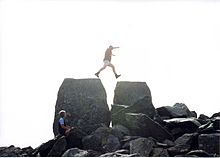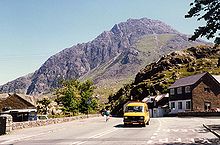- Tryfan
-
Tryfan 
Elevation 917.5 m (3,010 ft) [1] Prominence c. 188 m Parent peak Glyder Fawr Listing Marilyn Hewitt, Welsh 3000, Nuttall Translation three peaks / tops [2] (Welsh) Pronunciation Welsh: [ˈtrʌvæn] Location Location Conwy,  Wales
WalesRange Snowdonia Topo map OS Landranger 115 / Explorer OL17 OS grid SH664593 Tryfan is a mountain in Snowdonia, Wales, forming part of the Glyderau group. It is one of the most recognisable peaks in the region, having a classic pointed shape with rugged crags. At 3,010 feet above sea level it is the fifteenth highest mountain in Wales. Between the mid-1980s and June 2010, its accepted height was 3,002 ft, but it was resurveyed using accurate GPS measurements and found to be eight feet higher.[1] Until the 1980s, Ordnance Survey maps gave its height as 3,010 ft, and so the new measurement confirms that the earlier survey was correct.
Contents
Routes of ascent
All routes of ascent involve at least easy scrambling. Tryfan is the only mountain on the British mainland, and the only one in the United Kingdom outside the Cuillin of Skye, to require scrambling on the ascent, although there are a number of peaks (notably Helm Crag in the Lake District and The Cobbler in the Scottish Highlands) that involve a scramble to reach the highest point.
Tryfan is most often climbed from the north, as it lies close to the A5 road. A common starting point is about 1.5 km east of Idwal Cottage (a youth hostel) or Ogwen Cottage (an outdoor pursuits centre). From here a route leads up the rocky north ridge of the mountain, a Grade 1 scramble by the easiest line, although with opportunities for increasing the difficulty if the most direct line is followed throughout. About a third of the way up there is a distinctive rock known as "The Cannon" which points 45 degrees upwards and is visible from the ground on the profile of the mountain.
Tryfan may also be climbed from the south, where it is linked via Bristly Ridge to Glyder Fach. Bristly Ridge also offers good scrambling. Bwlch Tryfan, the saddle between Tryfan and the base of Bristly Ridge, may also be reached by a path leading up from Idwal Cottage to the west, passing through Cwm Bochlwyd. This cwm contains Llyn Bochlwyd, sometimes called "Australia Lake" or "Lake Australia" [3] due to the resemblance of its shape to that country.
The summit of Tryfan is noted for the rocks of Adam and Eve, a pair of rocks some three metres high and separated by 1.2 metres. The rocks are visible from the valley to the north-east, from where they resemble two human figures. It is customary for those climbing Tryfan to jump between the two rocks; in doing so one is said to gain the "Freedom of Tryfan". The exposure on one side is quite great and those without a head for heights are advised not to attempt the step. Adam is not easily scaled being high and smooth. There is a foothold on Eve which allows the climber to scramble to the top. Two prominent pillar-like boulders are visible on the skyline midway through the approach to the summit via the South ridge. As these can be mistaken for Adam and Eve from a distance, they have become known as Cain and Abel, continuing the biblical theme.
Milestone Buttress
Milestone Buttress at the base of Tryfan is a popular location for climbing. The Buttress is about 10 minutes walk from roadside laybys. The most popular route is known as the direct route: there are often queues of people waiting to climb it. It is 75 m long, and graded Very Difficult. The route was first climbed by G. Barlow and H. Priestly-Smith in 1910.
There is also a popular Grade 3 scramble incorporating the Milestone Buttress. This route is commonly used as an alternative approach to the North Ridge, as is the nearby slabby wedge of Tryfan Bach, on the other side of the mountain.
References
- ^ a b "Survey adds 8ft to Tryfan mountain's height". BBC News. June 24, 2010. http://news.bbc.co.uk/1/hi/wales/10401544.stm. Retrieved April 27, 2011.
- ^ Terry Batt (1994). Place-names in the 3000ft Mountains of Wales. Gwasg Carreg Gwalch. ISBN 9780863812828.
- ^ Joe Brown website
- ^ Nigel Spencer. "Tryfan". http://www.nigelspencer.co.uk/web-pages/uk-mountain-pages/wales-pages/wales-tryfan.htm.
Bibliography
- Williams, Paul (1990). Rock climbing in Snowdonia. Constable. ISBN 0-09-468410-3.
- Ashton, Steve (1992). Scrambles in Snowdonia. Cicerone. ISBN 1-85284-088-9.
External links
- Computer generated summit panoramas North South index
- Photos of Swansea University Hiking Clubs walk up Tryfan
- Climber's guide to Tryfan
- www.geograph.co.uk : photos of Tryfan and surrounding area
- Ascent of Tryfan via North Ridge
Welsh 3000s Snowdon Massif Glyderau Carneddau Categories:- Hewitts of Wales
- Marilyns of Wales
- Mountains and hills of Snowdonia
- Nuttalls
- Sites of Special Scientific Interest in West Gwynedd
- Geography of Conwy
- Climbing areas of Wales
Wikimedia Foundation. 2010.




